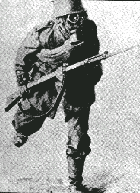War against war
War against war (in the original: ! War against the war Guerre à la Guerre War War Oorlog aan den Oorlog! ) Is a first time in 1924 published book of anti-militarists Ernst Friedrich . It illuminates the consequences of the First World War and wanted to show the true face of the war (wounded, maimed , executions, suffering, misery and dying). The book, which was originally published in four languages (German, French, English and Dutch), has been translated into around 50 other languages.
content
The German pacifist Friedrich tried with this book to shake people awake by showing the horror of a world war. A few years after the end of the First World War , it became the “Bible of the pacifists” who, in view of the horror of the trenches, tried to organize themselves under the motto “Never again war”. After a short introduction, he leaves the reader to himself.
According to the opinion that a picture is worth a thousand words, the book shows scenes from the First World War, among other things. Under a picture that shows different war toys, Friedrich demands: Don't give the children such toys! He denounces the euphemistic language of war propaganda by contrasting photographs from the front with subtitles. For example, he subtitled Field of Honor, a picture in which the naked corpse of a soldier who died of typhus is buried in a hole in the ground. He subtitled a mountain of corpses collected for a mass burial with Hero's grave .
This book also made the picture of terribly mutilated soldiers known. One sees an officer on a hospital bed with his mouth and lower jaw ripped off. A single flesh wound has taken its place. Friedrich subtitled with a saying by Field Marshal Paul von Hindenburg : The war gets me like a spa treatment! Another illustration of a war disabled received the comment from Count Moltke : The noblest virtues of people unfold in war! The book was all the more sensational as the most disfigured war victims were largely "hidden" from the public in remote homes for war invalids.
The book is structured in four languages, in German, English, French and Dutch. Friedrich has put a comment under each picture. At the end he appeals again against war and refers to his anti-war museum .
envelope
Later editions were designed by Udo Bruhn. The image of the soldier with a gas mask and attached bayonet became famous . Below only the comment: "The image of God with a gas mask."
Reviews
The book attracted worldwide attention, and it is still widely used today.
“We shouldn't show this book to our friends, those who are already pacifists, so we shouldn't repeat the old mistake that is so often made: sending missionaries to Rome - we should show it to our opponents. In meetings, in schools, in clubs, at regular tables - none of them know this horror. And the book should also be shown to women, especially women. "
“The photographs of the battlefields, these war coverings, the photographs of the mutilated victims are some of the most terrifying documents I have ever seen. There is no criminal work, no publication that offers something similar in terms of cruelty, ultimate truthfulness, instruction. "
"To those who have so often heard me affirmative, I suggest: Buy one or more copies of the book and ensure that it is distributed." Kurt Tucholsky in the Weltbühne.
"Ernst Friedrich opened my eyes to the most terrible of all epidemics, to the great cripple, the senseless exterminator war." Robert Jungk
pads
After the first edition in 1924, a new edition of the book was published by the Zweausendeins- Verlag in 1980 . Due to the high demand, it was then repeatedly reissued, including in 2004 by the Deutsche Verlags-Anstalt .
See also
- Karl Kraus: The last days of mankind
literature
- Ernst Friedrich: War against war! Guerre à la guerre. War against war! Oorlog aan den Oorlog !. 2 volumes. Free Youth, Berlin 1924 and 1926 ( DNB 560487576 )
- Ernst Friedrich: War against war. Reprint of the 1930 edition published by the first Anti-War Museum , with a foreword by Gerd Krumeich . dtv, Munich 2004, ISBN 978-3-421-05840-9 .
- Ernst Friedrich: War against war. Newly published by the current Anti-War Museum Berlin, with an introduction by Gerd Krumeich. Links, Berlin 2015, ISBN 978-3-86153-828-8 .
Web links
- Review notes . In: perlentaucher.de
- Martin Zähringer: "War against War". Well thought-out image discourse . In: deutschlandfunk.de (June 29, 2015)
Individual evidence
- ^ History special special issue No. 6: The First World War , p. 64; but Jörn Leonhard , "Die Büchse der Pandora", p. 568 denies this
- ↑ http://www.anti-kriegs-museum.de

